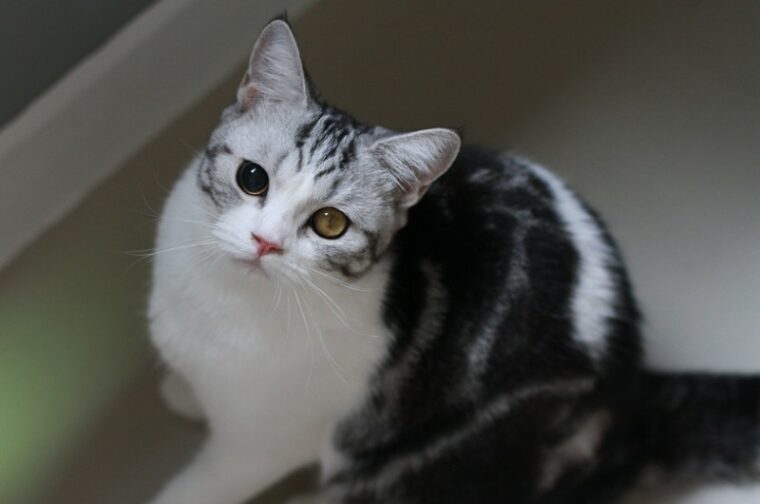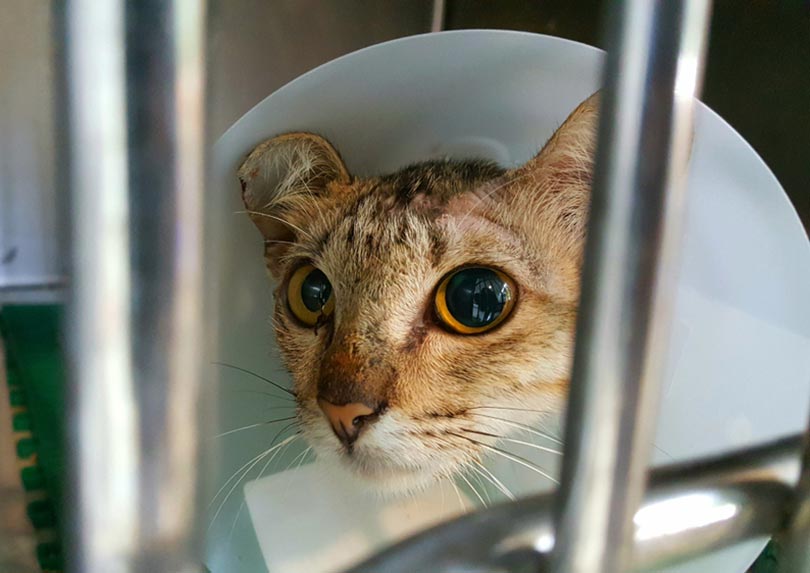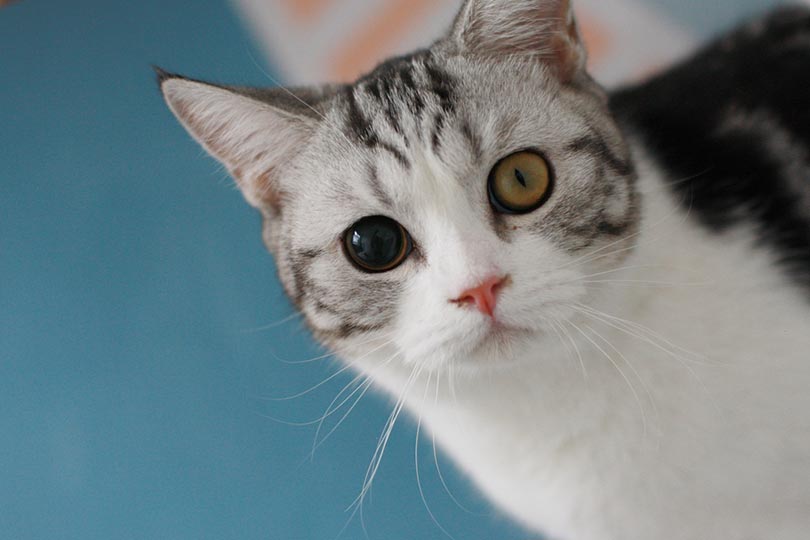
Click to Skip Ahead
Anisocoria in cats is seen more commonly than you might think. So, knowing a bit about the condition, its causes, signs, and how to care for a cat with anisocoria can go a long way in helping you identify if your cat is experiencing it, and what to do to help.
By definition, the condition involves a cat having two pupils of different sizes. Any cat can develop anisocoria, and it can be normal. Conversely, it can occur after trauma, infections, inflammation in the facial nerves, or from a variety of other conditions. When it appears, it generally indicates the need for concern and warrants a trip to your vet. Read on to learn more about anisocoria in cats.
What is Anisocoria?
Anisocoria is defined as a condition in which the pupils are different sizes—i.e., one is large, while the other is small. The condition is not specific to cats, however, it may be more noticeable in this species, as they tend to frequently have small, narrow pupils, which makes visual changes between the two pupils easier to identify.
Anatomically, the eye is made up of the iris, which is the pigmented or colored part of the eye. It is comprised of layers of muscle that contract or expand to allow different amounts of light through the lens or pupil, depending on ambient lighting conditions. Therefore, the disease is actually more a disease of the iris, rather than of the pupil itself—and any conditions which cause abnormal contraction or dilation of the iris can lead to anisocoria.
Depending on the cause, either the smaller or the large pupil can be the abnormal pupil.

What Are the Causes of Anisocoria?
Anisocoria can be caused by injury to the eye itself, which can result from falls, road traffic accidents, blunt trauma, catfights, or running into objects while playing. This can lead to inflammation or damage to sensitive structures around the eye, and result in anisocoria.
Anisocoria can also be caused by issues in the middle ear that impact the nerves which control eye function and run through the middle ear. This can include ear infections.
In rarer instances, anisocoria can be a normal part of the aging process. At present, it is not known why, some cats also seem to develop anisocoria as they age, without apparent illness. One theory is that age-related muscle weakness of the iris may play a role. In these cats, anisocoria is usually very subtle.
If you find that anisocoria has occurred in a short period in your cat—for instance, you wake up one morning and notice that there is a visual difference in the size of your cat’s pupils—you should consider this immediate cause to contact your vet. In these instances, having a photo of your cat’s face can also be extremely helpful to show your vet, and to document ongoing changes that may occur in the duration of the condition.
Where Are the Signs of Anisocoria?
The signs of anisocoria are fairly straightforward: one pupil is a different size than the other. Sometimes this can also occur in tandem with a change to the shape of the pupil, which is called dyscoria.
Sometimes, other signs may also be present, depending on the underlying cause. If inflammation is present, the eye may be reddened, feel warm to the touch, or even look dry. Squinting may or may not be present. If your cat has a pointed haircoat, these points are often temperature dependent. Therefore, if inflammation around the eye is longstanding, you may get color changes to the haircoat in these certain breeds as well (e.g., siamese cats).
If an ulcer is present, you will sometimes see tearing or watering of the eye. You may even see the ulcer as a divot on the eye’s surface for very large ulcers. Drooping of the eyelids and elevation of the third eyelid are additional components of anisocoria seen in Horner’s Syndrome.

How Do I Care For a Cat with Anisocoria?
Caring for a cat with anisocoria depends on the underlying cause of the condition. If the condition is considered to be from benign causes, idiopathic causes, or from age-related changes, it may be that no specific treatment is required.
However, if the underlying condition requires treatment, caring for a cat with anisocoria will be aimed at addressing this underlying disease. If there is inflammation present, anti-inflammatory medications might be used. If cancer is present, surgery to remove the eye may be a worst-case scenario. Otherwise, some forms of cancer may require radiation therapy or chemotherapy. If parasites are present, anti-parasitic treatments may be prescribed to your cat. It is not common that cats with anisocoria to be hospitalized for great lengths of time, and many cats are treated on an outpatient basis, with homecare as the primary means of addressing the issue.
Documenting the eye with photos on a regular basis can be helpful in monitoring response to treatment. Rechecks with your veterinarian may also be advised. Sometimes, further imaging or specialized ophthalmic equipment is needed to better monitor the condition, and your cat may be referred to a specialist in these instances. Such specialists may include veterinary neurologists, veterinary ophthalmologists, or veterinary oncologists.
In general, for cats with anisocoria, you don’t need to worry about restricting their activity levels, changing their routines, or offering special foods. Just follow the recommended advice and schedule for administering medications, and keep to any scheduled rechecks. Most causes of anisocoria should not be transmissible to other pets in the house, so isolating an affected cat is generally not necessary.
As always, check with your veterinarian for specific advice regarding your cat’s unique circumstances.
Frequently Asked Questions (FAQs)
Is anisocoria painful for cats?
The condition itself is not painful—remember, the pupils are made to dilate and contract, so it is a normal function of the eye. However, the underlying condition that causes the anisocoria may be painful—such as inflammation, an ulcer, or trauma to the face. If you suspect your cat is painful, speak to your vet about adding in an analgesic medication specific to cats to see if that might help.
When is anisocoria an emergency?
Anisocoria should always be seen by a vet for a complete evaluation. In cases when it suddenly appears, and you notice facial swelling, color changes to the eye or surrounding tissues, your cat seeming painful or uncomfortable, or not eating, blood, or anything else that may concern you, do not hesitate to seek emergency care. If in doubt, contact a veterinarian to discuss what you are seeing, and how quickly your cat needs to be seen. As a rule of thumb, eye issues in cats are never conditions to leave waiting.

What are the signs of pain in cats with anisocoria?
Conclusion
Anisocoria in cats can look quite odd, as we are generally used to seeing symmetrical facial features when looking at our feline friends! Anisocoria can either be highly pronounced or very subtle. Treating cats with anisocoria is often done successfully on an outpatient basis, and many cats will go on to make full recoveries. Rarely, a referral to a veterinary specialist for advanced care will be needed to better determine your cat’s progress. Remember, when it comes to cat’s eyes, never take any changes lightly—and if in doubt, always seek professional care!
See Also:
- Ehrlichiosis in Cats: Signs, Causes & Treatment (Vet Answer)
- How Many Eyelids Do Cats Have? Cat Eye Anatomy Explained
Featured Image Credit: HNP, Shutterstock







